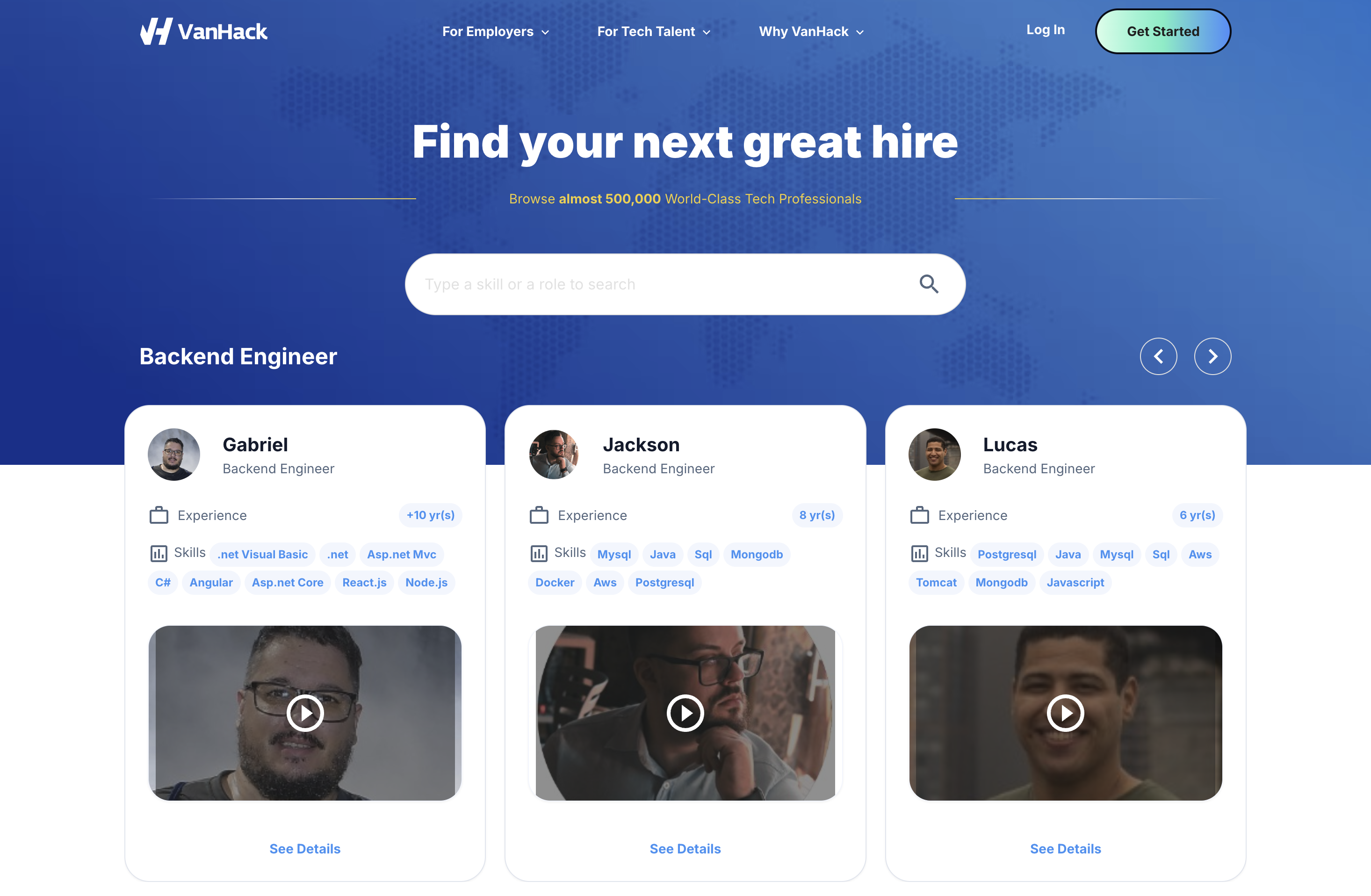Hiring skilled remote developers from Latin America offers US tech companies a strategic edge in 2025. With a growing pool of senior talent, time zone alignment, and cost advantages, LATAM has become a key region for building high-performing teams. This guide walks you through a clear framework for scouting talent in LATAM, covering strategy, vetting, cultural considerations, and logistical challenges. Follow these steps to gain a competitive advantage and scale efficiently. Recruit faster with VanHack.
Why LATAM Talent Scouting Is a Game-Changer for US Tech Companies
Understanding Today’s Engineering Talent Market
The US engineering talent market faces intense competition and rising costs, making it tough for growing companies to scale. Standard hiring methods like job boards or general agencies often fall short for startups with ambitious goals. Remote work, boosted by AI tools and global connectivity, has opened up new ways to access skilled professionals worldwide.
Senior engineering roles in the US come with high salary demands. Average annual pay for senior remote engineers hits $141,205, ranging from $120,000 to $173,000, with top earners exceeding $220,850. These costs, paired with competition from big tech and funded startups, create real hurdles for companies aiming to expand efficiently.
To stay ahead, US firms need to tap into global talent markets while keeping quality high. Accessing skilled professionals at sustainable rates can speed up product development and strengthen market position. A strategic focus on regions like LATAM offers a practical solution.
What Makes LATAM a Top Choice for Remote Developers?
Latin America stands out for US companies looking to enhance their engineering teams. Its close proximity means significant overlap in working hours, allowing for real-time collaboration during standard business times. This setup supports team unity and project progress better than many other global regions.
Many LATAM developers also bring strong English skills and an understanding of US business practices, easing their integration into remote teams. The region’s established remote work culture, built from years of working with international clients, ensures smooth collaboration in distributed setups.
Cost savings add to the appeal. Remote developers in LATAM earn an average of $60,363 annually, compared to $141,205 for US-based developers. Typical salaries in the region range between $30,000 and $60,000 per year. These figures reflect meaningful savings without sacrificing skill level, as many developers match or exceed US talent in technical ability.
Key tech hubs in cities like São Paulo, Mexico City, Buenos Aires, Bogotá, and Santiago nurture high-quality talent. Strong educational systems and active startup communities in these areas produce experienced developers across various tech skills, ready to meet US company needs.
How to Build a Strong LATAM Talent Scouting Strategy
Step 1: Clarify Your Hiring Goals and Needs
Effective talent scouting in LATAM starts with defining your specific requirements. This goes beyond basic recruiting to include sourcing, vetting, cultural fit, and managing remote international staff. Unlike local hiring, this process demands a broader approach tailored to global teams.
Align your hiring plan with business goals, such as product timelines, funding schedules, and market objectives. Decide whether to build an in-house global recruiting team or partner with a specialized platform, based on your resources and growth pace.
Consider hiring volume, internal HR capacity, compliance needs, and urgency when choosing between building or outsourcing. Companies hiring frequently might benefit from internal systems, while those with urgent or occasional needs may gain more from external expertise.
For remote roles, clearly outline expectations for senior positions, distinguishing between full-stack, backend, and frontend skills. Set criteria for technical ability, cultural alignment, and remote work effectiveness to guide your candidate evaluations.
Step 2: Get to Know the LATAM Developer Market
The LATAM developer market varies by country, affecting hiring approaches and outcomes. Here’s a quick breakdown of key regions:
- Mexico leads in nearshoring for US companies with strong time zone alignment and skills in cloud and AI technologies. Senior developers here earn around $80 per hour.
- Brazil and Colombia have deep talent pools in cities like São Paulo, Rio de Janeiro, Bogotá, and Medellín. Brazilian developers earn $40 to $60 per hour, while Colombian specialists can reach $70 per hour.
- Argentina offers high English proficiency and a mature remote work culture, with rates between $35 and $55 per hour. Currency fluctuations here require regular pay adjustments.
- Chile has the highest rates, with developers earning up to $90 per hour, excelling in DevOps, cybersecurity, and data engineering, especially for enterprise and fintech roles.
Market trends show rising demand. LATAM tech salaries have increased 15 to 25% due to global competition, with bilingual skills adding a 10 to 20% pay boost. Specialized roles like Cloud Architects and AI specialists also see higher pay, often between $60,000 and $75,000 annually, reflecting their unique value.
Step 3: Source and Vet Remote LATAM Talent Effectively
Finding top LATAM talent means going beyond job boards. Engage with local tech communities, use platforms built for global hiring, and connect with regional tech hubs or universities for better results.
Vetting remote candidates requires a detailed approach. Resumes alone won’t reveal true skills or fit. Use multi-dimensional assessments to evaluate technical expertise, communication, and cultural alignment accurately.
For technical skills, focus on live coding sessions, architectural discussions, and real-world scenario tests. These methods assess problem-solving and collaboration, considering time zone differences to ensure fair evaluations.
Cultural fit matters just as much. Look for self-motivation, clear communication, and adaptability to remote setups. Develop specific criteria to assess these qualities alongside technical skills for long-term team success.
Communication is key in remote roles. Test English proficiency in speaking, writing, and technical explanations. Video assessments can show how candidates express complex ideas and work with US teams effectively.
Step 4: Manage Cultural and Logistical Challenges
Integrating LATAM developers into US teams starts with understanding cultural differences. Create onboarding programs that bridge professional practices, communication styles, and collaboration norms while valuing diverse perspectives.
Time zone coordination needs careful planning. Set core hours for overlap, use asynchronous tools, and document processes to support decisions across regions. This keeps productivity high and teams connected.
Legal and compliance rules differ across LATAM countries. Whether hiring directly, using contractors, or an employer-of-record, know the tax, labor, and IP laws in each market to avoid issues.
Compensation management involves navigating local banking, currency preferences, and payment methods. Many developers prefer USD to offset currency volatility, while others need local payments. Build flexible systems to handle these needs.
If relocation is an option, global mobility support becomes vital. Visa processes and logistics demand expertise. Partnering with platforms offering these services can ease the administrative load for both company and candidate.
VanHack: Your Partner for Hiring Remote LATAM Developers
VanHack simplifies the process of hiring remote LATAM developers for US companies. Focused on pre-vetted, senior tech talent from global markets, it offers a complete solution to tackle the challenges of international recruiting.

Targeting scaling startups from Series A to Series C with at least 20 employees, VanHack understands the needs of growing tech firms. Its talent pool includes over 500,000 professionals, with a strong focus on LATAM, where time zone and cultural alignment benefit US teams.
Speed Up Hiring with AI-Driven Vetting
VanHack’s AI tool, Vanna, streamlines candidate matching. Using advanced language models, it analyzes job needs against candidate profiles, considering skills, salary expectations, and experience for precise matches.
This system delivers shortlists of 3 to 5 top candidates, cutting through unqualified applicants. It automates advancement to review stages, saving time and letting recruiters focus on the best talent.
VanHack also offers detailed vetting through video introductions for communication insights, objective coding tests via platforms like Woven for skill validation, and AI-led technical interviews. These 30-minute sessions provide recordings, transcripts, and scores, showing real problem-solving and reasoning skills without needing live team involvement.
Simplify Relocation with Global Mobility Support
VanHack’s Global Mobility team handles the complexities of international relocation. Its in-house experts manage visa processes, valued at around $5,000, at no extra cost, covering applications for candidates and families.
Relocation support includes housing, flights, school placement, and local orientation, managed by a dedicated coordinator. Candidates can start working remotely during visa processing, delivering value immediately.
After relocation, VanHack connects new hires to local communities via WhatsApp groups. These networks help with cultural adjustment and build long-term retention through professional and social ties.
Scale Easily with Predictable Hiring Costs
VanHack’s subscription model, Vanna, offers unlimited hires for a flat $3,000 monthly fee. This eliminates per-hire costs, providing budget clarity for scaling companies.
For instance, a client hired seven developers for $9,000 with VanHack, compared to over $100,000 via traditional agencies. These savings can fund additional hires or growth projects.
This pricing removes financial risks in exploring candidates or adding staff. It supports bold hiring plans without escalating costs, aligning VanHack’s goals with client success for efficient, quality placements.
Make Informed Choices with Detailed Candidate Profiles
VanHack’s platform consolidates vetting data into detailed profiles for quick evaluation. Video intros show communication and personality, while AI interview recordings reveal problem-solving and technical skills.
Objective scores and benchmarks provide hard data for decisions. A Kanban-style dashboard, direct messaging, and one-click scheduling simplify candidate tracking and team collaboration.
Start hiring with VanHack to access tools and services tailored for remote LATAM talent acquisition.
Common Mistakes to Avoid When Hiring Remote LATAM Developers
Overlooking Cultural Differences
Many US companies miss the mark by not prioritizing cultural onboarding. Even with strong English skills, differences in communication, feedback, and collaboration styles can cause misunderstandings if ignored.
Address variations in directness, hierarchy, and conflict resolution through cultural training. Encourage open dialogue and create space for diverse work styles to enhance team performance.
Adapt communication for feedback comfort levels and presentation styles. Some LATAM developers may need prompts to share opinions or communicate indirectly. Recognizing these differences prevents missteps and boosts contribution.
Skimping on Candidate Vetting
Relying on shallow vetting like resume reviews often leads to skill or fit mismatches in remote hiring. Without direct interaction, key signals about ability and style get missed.
Go beyond basic coding tests. Assess problem-solving, technical communication, and independent work skills, which are vital for remote success but hidden in standard screens.
For cultural fit, use structured methods to evaluate self-direction and adaptability. Specific frameworks reveal working styles better than brief chats, ensuring lasting team alignment.
Misjudging Compensation Offers
Setting pay without understanding LATAM market rates and living costs can backfire. While senior developers earn $30,000 to $50,000 annually in 2025, adjusting for local costs is essential. Generic salary bands often fail to attract talent or strain budgets.
Account for regional pay differences, currency issues, and living expenses. In Argentina, frequent pay reviews handle inflation, while Brazil offers stability and Colombia sees rising premiums. Develop policies for fair, competitive offers across markets.
Ignoring Employer Branding
Competing for LATAM talent requires a strong employer brand. With global remote opportunities growing, top developers can choose where to work. Without a clear value proposition, attracting and keeping talent becomes hard.
Highlight career growth, skill development, and cultural support in your branding. Show a genuine commitment to remote team success, ensuring equal contribution and advancement for all staff.
Underestimating Legal and Administrative Needs
International hiring brings complex legal and admin tasks that catch many companies off guard. Employment laws, taxes, and IP rules vary widely across LATAM, unlike familiar US practices.
Payroll challenges include currency conversions, local banking, and tax compliance. Unexpected costs and delays arise without experience, affecting efficiency and budgets.
Data security and IP ownership need careful planning. Set clear policies and protocols to protect information and meet regulations across borders. Choose employment structures wisely to balance risks and needs.
Key Questions About Hiring Remote LATAM Developers
How Do LATAM Developer Salaries Compare to US Rates?
LATAM offers significant cost advantages for US companies. Average annual pay for remote developers is $60,363 in LATAM, compared to $141,205 in the US, with typical ranges of $30,000 to $60,000. Lower living costs in cities like São Paulo and Mexico City mean these salaries support a high quality of life while saving employers money.
Specialized roles, like Cloud Architects or AI experts, earn $60,000 to $75,000 in LATAM, far below the $150,000 to $250,000 for similar US positions. Despite recent salary increases of 15 to 25% due to global demand, and bilingual premiums of 10 to 20%, LATAM remains a cost-effective choice for quality talent.
What Unique Benefits Do LATAM Countries Offer for Developer Hiring?
Each LATAM market brings specific strengths for US firms:
- Mexico excels in nearshoring with time zone alignment and expertise in cloud and AI, plus close cultural ties to US practices.
- Brazil and Colombia provide large talent pools in cities like São Paulo and Bogotá, with strong skills in large systems and emerging tech.
- Argentina stands out for English fluency and remote work experience, adapting easily to US team dynamics.
- Chile offers advanced skills in DevOps and cybersecurity, ideal for complex enterprise and fintech projects.
All these regions align better with US time zones than Asia or Europe, supporting real-time teamwork and agile workflows.
How Has the LATAM Tech Talent Market Evolved Recently?
The LATAM tech market has grown rapidly with global remote work trends. Salaries have risen 15 to 25% due to increased demand from US and European firms seeking affordable talent.
Specialized skills in cloud, AI, and DevOps now fetch $60,000 to $75,000 annually, with top rates for AI in Mexico at $60,000 and DevOps in Brazil at $70,000. Bilingual abilities add a 10 to 20% pay boost, valuing cultural bridging in remote teams. While salary gaps narrow, cost-of-living differences keep LATAM attractive.
Why Is English Proficiency Crucial for LATAM Developers?
Strong English skills are vital for LATAM developers in US teams, impacting daily communication, technical discussions, and career growth. They need fluency in speaking for calls, clarity in writing for documentation, and precision in explaining complex ideas.
Countries like Argentina often show high proficiency, enabling seamless integration. Assess communication through video scenarios, focusing on technical explanations and problem-solving, matching skills to role needs like client-facing or coding-focused tasks.
Find top talent with VanHack’s vetting process, including video and AI-driven interviews to confirm communication readiness for remote success.
Conclusion: Gain an Edge with VanHack’s LATAM Talent Solutions
Scouting talent in Latin America opens doors for US companies to build skilled engineering teams at sustainable costs. With technical expertise, cultural fit, time zone benefits, and savings, the region offers unique value if you navigate hiring challenges well.
From vetting and cultural onboarding to legal and mobility issues, international hiring is complex. VanHack addresses these with AI matching, thorough vetting, and relocation support, all in one platform for LATAM developer hiring.
As remote teams shape the tech landscape, mastering LATAM hiring gives you an edge in speed, cost management, and skill access. Blend US strategy with LATAM talent for lasting success.
Want to scale your engineering team with elite talent? Connect with the right candidates now through VanHack and rethink your approach to remote hiring.



